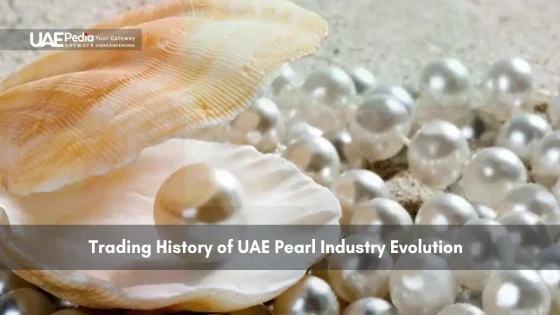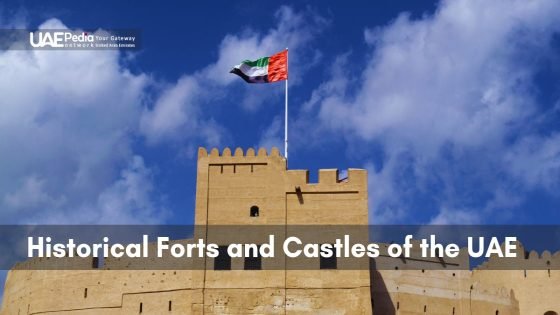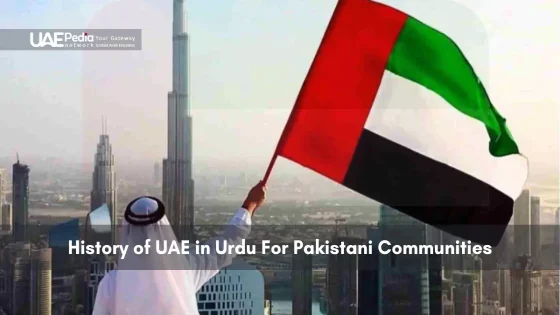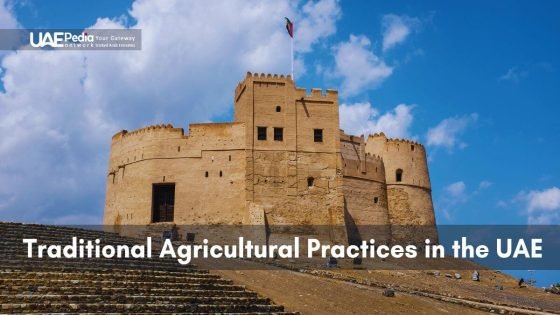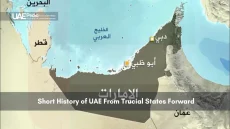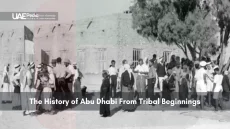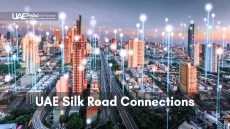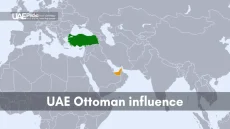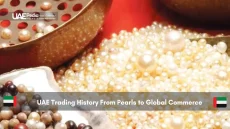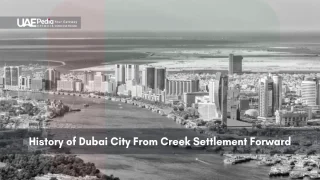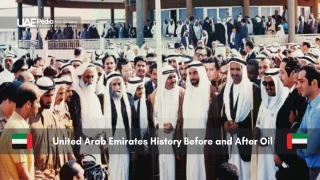Did you know the UAE’s coastal communities were trading pearls 125,000 years before skyscrapers dotted the skyline? Long before oil transformed the landscape, ghawaṣ (divers) braved the Gulf’s depths to harvest iridescent treasures that connected this region to Mesopotamia and the Indus Valley. This legacy of adaptation still pulses through the seven emirates today.
Our story begins where land meets sea. Ancient settlements along the Arabian Gulf coast evolved into bustling hubs, their wooden dhows carrying more than goods—they transported ideas. When British-protected Trucial States united in 1971, they didn’t abandon this commercial DNA. Instead, they amplified it through visionary infrastructure and maritime trade policies that turned fishing villages into global ports.
Consider this transformation:
- Desert meets destiny: How pearl beds shaped early economic networks
- Resourcefulness redefined: From diving boats to sovereign wealth funds
- Unity in diversity: Seven distinct emirates creating one economic powerhouse
Tomorrow’s entrepreneurs walk the same shores where merchants once traded crimson-dyed textiles for Chinese porcelain. As we explore this journey, you’ll discover why the nation’s past isn’t just preserved in museums—it’s coded into every modern achievement.
Foundations of Trading in the Ancient UAE
Imagine walking along the arab emirates coastline 125,000 years ago—your footprints mingling with those of early inhabitants shaping stone tools. These pioneers didn’t just survive here—they thrived by turning the coast into a launchpad for connections that stretched across oceans.
Prehistoric Maritime Connections and Early Settlements
Archaeologists still find oyster shells and fish bones in the area, whispering stories of resourceful communities. Prehistoric sailors here built reed boats to exchange volcanic glass from Yemen for Mesopotamian barley—creating the region’s first economic network. Their settlements clustered near natural harbors, where fresh water met marine abundance.
Think of these seafarers as the original influencers. They didn’t just move goods—they blended languages, technologies, and traditions. A Bronze Age bracelet found in Sharjah matches designs from the Indus Valley, proving ideas traveled as fast as spices.
Trade with the Indus Valley and Mesopotamia
What made the united arab coast so special? Geography gifted it with:
- Shallow waters perfect for fishing and pearl diving
- Monsoon winds that pushed dhows toward India
- Strategic position between two river-based superpowers
By 3000 BCE, ships from modern-day Iraq docked here for copper, while Indus Valley traders sought Gulf pearls. This wasn’t just commerce—it was cultural cross-pollination. Mesopotamian clay tablets mention “Magan,” believed to be the united arab emirates’ ancient name, trading timber and semiprecious stones.
These early exchanges coded a trade mindset into the arab emirates’ DNA. Today’s mega-ports in Dubai and Abu Dhabi didn’t emerge from sand—they’re chapters in a story written by tide and tenacity.
Flourishing Economies in the Bronze and Iron Ages
What if we told you the arab emirates hosted the Silicon Valley of 2000 BCE? This era wasn’t about survival—it was about economy-shaping breakthroughs. Communities from Al Ain to Umm Al Quwain engineered solutions that turned harsh landscapes into breadbaskets, their innovations rippling across the ancient world.
Umm Al Nar and Wadi Suq Cultures
Dig into the red sands near Ras Al Khaimah, and you’ll find the fingerprints of trendsetters. The Umm Al Nar people (2700-2000 BCE) built circular tombs with precision-cut stone—architectural marvels that doubled as trade markers. Their Wadi Suq successors mastered copper smelting, turning the Hajar Mountains into a Bronze Age industrial zone.
At Tell Abraq, archaeologists uncovered a 4,000-year-old warehouse stocked with Indus Valley pottery and Mesopotamian textiles. These weren’t just goods—they were receipts from the united arab’s first global marketplace.
Advancements in Irrigation, Metallurgy, and Trade Routes
Three game-changers fueled the area’s prosperity:
- Falaj magic: Gravity-fed water channels transformed oases into farm hubs
- Metal mastery: Local smiths produced bronze tools rivaling Mesopotamian quality
- Dhow diplomacy: Coastal settlements became pit stops for ships sailing between Dilmun and Meluhha
By 1300 BCE, the coast buzzed with merchants exchanging Arabian copper for Indian ivory. This network laid groundwork for what would become the united arab emirates’ economic DNA—adaptable, interconnected, resource-smart.
Sound familiar? Today’s vertical farms and AI-powered ports echo that same innovative spirit. The people here have always known how to turn limitations into launchpads.
The Islamic Era and Maritime Trade Expansion
What if crossroads of faith and commerce reshaped an entire region? The 7th century CE brought more than spiritual awakening—it rewired the arab emirates’ economic compass. As Islam spread across the coast, ports became pulpits where merchants preached through deals rather than sermons.
Conversion and the Battle of Dibba
Picture this: 632 CE, waves crashing near Dibba as rival factions clash over faith and power. This decisive battle didn’t just secure Islam’s foothold—it fused spiritual and commercial networks. Coastal leaders quickly realized unity under one belief system meant safer trade routes. Shared values became shared ledgers.
Dibba’s victory ripple transformed ports into cultural melting pots. Ships from Oman to Persia now carried Quranic manuscripts alongside frankincense. The scent of cooperation lingered heavier than spices in Julfar’s markets.
Julfar, Dibba, and the Eastern Arab Trading Network
Julfar emerged as the Dubai of its day—a harbor where Chinese celadon met African ivory. Three factors supercharged this network:
- Monsoon winds timed with pilgrimage routes
- Standardized Islamic trade laws reducing disputes
- Coastal government alliances protecting merchant fleets
By 900 CE, Julfar’s dhows reached Zanzibar and Guangzhou. This wasn’t just business—it was diplomatic chess. When a united arab trader spoke, sultans and emperors listened.
Today’s free zones echo this legacy. The same coast that hosted pearl divers now welcomes container ships, proving some tides never really change—they just find new shores.
The Impact of Portuguese and British Influences
What happens when global superpowers collide with coastal traders? The 16th century brought cannon smoke to the arab emirates’ shores as Portuguese warships disrupted centuries-old networks. But here’s the twist—the people didn’t retreat. They recalibrated, proving resilience isn’t just surviving storms but dancing in the rain.
Colonial Disruptions and the Emergence of Trucial States
Portugal’s 1507 attack on Ras Al Khaimah left ports smoldering—but only temporarily. Within decades, local leaders rebuilt while eyeing new allies. Enter the British, offering “protection” treaties in 1820. These pacts birthed the Trucial States, a clever rebranding of adversity into opportunity.
Three seismic shifts reshaped the coast:
- Power plays: British naval dominance forced rival sheikhdoms to unite
- Trade pivots: Pearl merchants shifted routes to avoid colonial taxes
- Government evolution: Tribal councils formalized into recognized leadership
The 1819 sacking of Ras Al Khaimah’s forts became a rallying cry. As one British officer wrote: “They rebuild faster than we can burn.” By 1892, the Trucial States had negotiated non-interference clauses—keeping their culture intact while leveraging British muscle against Ottoman advances.
Today’s united arab emirates mirrors this pragmatism. Those 19th-century treaties didn’t just prevent colonization—they planted seeds for a federation that would later harness oil wealth. The scent of gunpowder faded, but the art of turning threats into treaties? That’s woven into the state’s DNA.
Trucial States and the Road to Federation
Picture this: seven sheikhdoms along the Arabian Gulf coast, each with distinct identities, deciding their future wasn’t in isolation but unity. The Trucial States transformed from British-protected territories to a sovereign federation through shrewd diplomacy—like neighbors merging backyards to build a mansion everyone could enjoy.
Formation of the Trucial Agreements and External Treaties
Sheikh Zayed bin Sultan Al Nahyan and Sheikh Rashid bin Saeed Al Maktoum weren’t just leaders—they were architects of consensus. Their 1968 meeting in the desert sparked what locals call “the agreement heard round the Gulf.” By 1971, six emirates signed a constitution balancing local autonomy with collective strength.
Three pillars supported this government evolution:
- Treaty of 1892: British non-interference in internal affairs
- 1952 Trucial Council: First joint decision-making body
- 1968 London Agreement: Planned British withdrawal timeline
| Treaty | Year | Impact |
|---|---|---|
| Perpetual Maritime Truce | 1853 | Ended naval conflicts between sheikhdoms |
| Exclusive Agreement | 1892 | Established British protection framework |
| Union Accord | 1971 | Created UAE federal structure |
The people’s shared experience as pearl traders and desert survivors forged trust. As Sheikh Zayed often remarked: “We built towers not from sand, but from handshakes.” This collaborative DNA now pulses through Dubai’s stock exchange and Abu Dhabi’s renewable energy projects alike.
trading history of uae
How does a coastline become a crossroads of civilizations? The answer lies in layers of sand-stained ledgers and salt-crusted dhows. What began with ghawaṣ divers exchanging pearls for Mesopotamian barley evolved into one of Earth’s most dynamic economies—all while keeping its soul rooted in that same sunbaked coast.
Three seismic shifts define this journey:
- Bronze Age ingenuity: Copper traders mapping routes later used by oil tankers
- Islamic-era diplomacy: Shared faith creating trust across merchant networks
- 20th-century vision: Tribal councils morphing into a unified federal government
You can still trace these patterns today. The arab emirates didn’t abandon their pearl-diving tenacity—they repurposed it. Where wooden ships once carried oyster harvests, container vessels now transport semiconductor chips. That gritty resolve to rebuild after Portuguese invasions? It’s the same spirit fueling Dubai’s AI-powered customs systems.
“We don’t inherit trade routes—we reimagine them.”
Modern skylines mirror ancient souqs in their purpose. Both serve as meeting points where the world exchanges goods, ideas, and ambitions. From Julfar’s medieval harbor to Jebel Ali’s mega-port, the united arab emirates has always known: true wealth isn’t found in the ground or sea—it’s built through connections.
Pearling Industry: Economic and Social Driving Forces
Ever wonder how pearls built empires? For centuries, the arab emirates thrived on an aquatic treasure hunt where entire villages held their breath—literally. From May to September, ghawaṣ divers plunged 30 meters on single breaths, their calloused hands sifting oyster beds while mothers prayed ashore. This wasn’t just work—it was a rhythm that pulsed through coastal life.
Mechanics of the Pearling Trade and Local Practices
The trade operated like clockwork. Divers rose at dawn, tied nose clips made from turtle shells, and descended with woven baskets. Boat captains—nakhudas—kept meticulous logs, while pearl merchants graded finds by moonlight. Everyone from rope-makers to cooks shared profits through a “khums” system, ensuring even children earned dates for school.
Community Impact and Socioeconomic Transformation
Pearls didn’t just buy goods—they built futures. Successful seasons funded weddings, mosques, and date farms. When Japanese cultured pearls flooded markets in the 1930s, the government pivoted skills to fishing and oil exploration. Today, Emirati grandmothers keep pearl necklaces as living heirlooms, while museums teach visitors to string oysters—turning tourism into a new kind of treasure dive.
As one pearl merchant’s ledger reads: “We traded drops of sweat for droplets of saltwater gold.” That grit now fuels Dubai’s luxury markets and Abu Dhabi’s heritage tours, proving the people here still know how to make waves.
Shift to a Petroleum-Based Economy and Diversification
What if black gold rewrote a nation’s destiny overnight? When oil gushed from Abu Dhabi’s desert in 1958, the arab emirates didn’t just strike wealth—they ignited a people-powered renaissance. Sheikh Zayed bin Sultan Al Nahyan’s famous decree—“Transform every dirham into lasting progress”—turned rigs into roads and pipelines into schools.
Oil revenues reshaped the united arab emirates like monsoon winds redirect trade routes. By 1975, the government funneled 70% of budgets into infrastructure. Think airports where camel caravans once camped, hospitals replacing pearl-diver clinics. But here’s the twist—they treated oil as seed money, not the harvest.
Three smart pivots secured tomorrow:
- Future-proofing: Abu Dhabi’s Masdar City sprouted from sand, banking on renewables
- Trade reimagined: Dubai’s Jebel Ali port became a robotics-powered gateway
- Cultural capital: Louvre Abu Dhabi merged Bedouin patterns with global art
Today’s economy dances between tradition and innovation. Where pearl merchants once haggled over oyster sizes, crypto traders now debate blockchain. The federation’s non-oil sectors contribute 70% to GDP—tourism alone welcomes 25 million annual visitors craving both skyscrapers and souks.
As Sheikh Zayed often quipped: “Pearls built our past, but oil? That’s just the fuel for our next dive.” From desert wells to Mars missions, the united arab playbook remains clear—harvest today’s resources to plant forests you’ll never sit under.
Modern Trading Practices and Global Integration
Where else can ancient souq haggling skills meet blockchain-powered markets? The united arab emirates has turned its historic trade DNA into a 21st-century superpower, blending Bedouin bargaining with AI-driven logistics. From Dubai’s tax-free zones to Abu Dhabi’s fintech sandboxes, this coast now welcomes both camel caravans and crypto traders.
Financial Hubs and Free Zones
Dubai International Financial Centre buzzes like a modern pearl market—except here, deals shimmer in digital currencies. Over 30 free zones offer 100% foreign ownership, attracting 15,000 global firms. Jebel Ali Port handles 13.7 million containers yearly, while Abu Dhabi’s Masdar City trades solar credits like Bronze Age merchants swapped copper ingots.
Tourism and Economic Synergy
Twenty-five million annual visitors don’t just snap Burj Khalifa selfies—they fuel a $30 billion tourism economy. Luxury resorts neighbor spice souqs where saffron still sells by the gram. Expo 2020 Dubai proved the government’s playbook: build futuristic stages where the world’s innovators pitch their wares.
Three forces drive this economy:
- Tradition 2.0: Date farms using IoT sensors, pearl museums hosting NFT auctions
- Connectivity: Emirates airlines linking 150 cities, digital nomad visas luring remote workers
- Cultural bridges: Louvre Abu Dhabi exhibitions sparking art deals, Ras Al Khaimah adventure tours boosting gear sales
“We don’t wait for trends—we design them.”
As desert sunsets paint skyscrapers gold, the arab emirates reminds us: true power lies not in resources, but in reinvention. Whether you’re sealing deals in DIFC towers or bartering in Deira’s alleyways, this region remains humanity’s original global marketplace—just with better Wi-Fi.
Economic Data and Global Trade Relations
How does a desert nation become a global trade titan? The united arab emirates’ economic story reads like an ancient ledger—each entry revealing how scarcity bred innovation. From pearl-packed dhows to oil tankers, this coast has always turned limitations into launchpads.
Key Import and Export Figures over Centuries
Let’s crunch numbers that shaped empires. In the 19th century, pearls accounted for 95% of the arab emirates’ exports—worth $1.5 billion annually today. Fast-forward to 2023: non-oil foreign trade hit $952 billion, with Dubai alone processing 14.8 million containers.
Three pivotal shifts stand out:
- From pearls to pipelines: Oil’s 1960s boom saw exports jump 400% in a decade
- Gateways, not just goods: Jebel Ali Port now handles trade for 3.5 billion people
- Digital dunes: E-commerce grew 23% last year, mirroring ancient barter networks
The government’s playbook? Build infrastructure first. Free zones contribute 33% to GDP today—same as pearls did in 1900. When China’s Belt and Road Initiative needed a hub, the united arab emirates offered 700+ weekly cargo flights.
As Sheikh Zayed once noted: “Our ancestors traded across deserts; we connect continents.” From frankincense routes to AI-powered customs, this region still writes trade’s playbook—one bold deal at a time.
Trade Infrastructure and Strategic Initiatives
Think of a desert coastline transforming into a global trade superhighway. The government has engineered this vision through ports that move mountains of containers and free zones buzzing with startups. Khalifa Port’s cranes now stack shipping boxes where pearl divers once anchored—a $7.2 billion project handling 15 million TEUs annually.
- Jebel Ali Free Zone hosts 8,400 companies with tax incentives
- Dubai’s Digital Silk Road initiative links 100+ smart logistics platforms
- Abu Dhabi’s KIZAD industrial zone produces aluminum for SpaceX rockets
The state doesn’t just build infrastructure—it architects ecosystems. Take DP World’s “Trade 2030” plan: drone deliveries, blockchain customs, and AI-powered cargo matching. This isn’t sci-fi. It’s Tuesday at Jebel Ali Port.
| Project | Location | Impact |
|---|---|---|
| Khalifa Port Expansion | Abu Dhabi | +22% regional trade capacity |
| Dubai Logistics Corridor | Dubai | Links airport & port in 15 minutes |
| RAKEZ Industrial Zone | Ras Al Khaimah | 3,200 manufacturing licenses issued |
Media campaigns like “Next Gen Trade” showcase these innovations globally. The government partners with YouTube creators and CNBC analysts to rebrand the arab emirates as Earth’s digital trade crossroads. As Sheikh Mohammed bin Rashid notes: “Our cranes don’t lift containers—they elevate possibilities.”
From Fujairah’s oil storage farms to Sharjah’s art shipping hubs, every place tells the same story. When trade flows, prosperity follows. The coast that once launched pearl dhows now launches economic revolutions.
The Role of Government and Policy in Trade Evolution
What transforms a desert coastline into a trillion-dollar economy? Smart policies and leaders who treat trade as a living tradition. The government here doesn’t just regulate markets—it architects them, blending Bedouin negotiation tactics with Silicon Valley agility.
Regulatory Frameworks and Trade Agreements
Sheikh Zayed bin Sultan Al Nahyan once said: “A good treaty outlives its signatories.” This philosophy shaped landmark deals like:
- The 2022 Comprehensive Economic Partnership Agreement with India
- Dubai’s 1985 Jebel Ali Free Zone blueprint
- Abu Dhabi’s 2030 Economic Vision diversification plan
| Policy | Year | Impact |
|---|---|---|
| Foreign Direct Investment Law | 2018 | Allowed 100% foreign business ownership |
| UAE-Israel Abraham Accords | 2020 | Boosted tech trade by $1.2 billion |
| Corporate Tax Exemptions | 2023 | Attracted 800+ startups in 12 months |
Government-Led Economic Diversification
Rashid bin Saeed Al Maktoum’s 1979 port expansion proved visionary. Today’s government invests 4% of GDP in AI and renewables—mirroring how pearl profits once funded date farms. Three modern strategies stand out:
- Future incubators: Masdar City’s green tech hub
- Trade bridges: Emirates’ 150+ air routes
- Skill swaps: Golden Visa programs attracting global talent
The federation’s secret? Treat policies like pearl strings—each initiative a bead that gains value when connected. As one minister told us: “We don’t chase trends. We build the sandboxes they play in.”
Reflections on the UAE’s Trading Legacy
How does a nation rewrite its story without erasing the past? The united arab emirates answers through dhows turned data centers and pearl paths repaved as digital highways. Ancient ghawaṣ divers laid foundations for today’s free zones—their grit mirrored in Emirati entrepreneurs coding blockchain solutions where coral reefs once thrived.
From Bronze Age copper traders to Expo 2020’s global showcases, this arab emirates journey reveals a pattern: scarcity breeds reinvention. The government’s fusion of tradition with futurism—think AI customs systems and solar-powered desalination—proves economic DNA adapts but never forgets.
Three threads weave through centuries:
Resilient networks: Shared waters once carrying pearls now host 45% of global container traffic.
Cultural continuity: Souq haggling skills shape today’s luxury markets and NFT auctions.
Visionary balance: Oil wealth funds Mars missions while preserving mangrove nurseries.
Tourists marvel at Burj Khalifa’s height but miss its roots—it stands where merchants once weighed frankincense. Yet the people know: those bartered spices flavored today’s fusion feasts in Jumeirah’s beachfront bistros.
As desert stars witness new trade pacts and hyperloop prototypes, the federation whispers an eternal truth: progress honors heritage when it builds bridges, not walls. Ready to trace these connections yourself? The world’s original crossroads still has secrets to share—if you know where to listen.
Pearling wasn’t just an industry—it was a way of life. Communities revolved around seasonal dives, with songs, rituals, and even financial systems like salafiya loans tied to the trade. When oil emerged, Sheikh Zayed bin Sultan Al Nahyan wisely reinvested revenues into infrastructure, education, and healthcare, creating today’s diversified economy.
The 1820 General Maritime Treaty and later Trucial States agreements curbed piracy but tied the region to British foreign policy until 1971. These deals stabilized trade routes, setting the stage for ports like Dubai Creek to flourish as safe hubs for merchants across the Indian Ocean.
Coastal settlements like Umm Al Nar (2600–2000 BCE) swapped copper, pearls, and pottery with Mesopotamia and the Indus Valley. Don’t miss the Hili Archaeological Park in Al Ain—its tombs and artifacts reveal how interconnected this region was 4,000 years ago!
Near modern-day Ras Al Khaimah, Julfar thrived as a medieval port linking Arabia to India and East Africa. Its merchants exported pearls, horses, and dates while importing spices and textiles. Portuguese invasions in the 16th century disrupted this—until local tribes regained control.
Visionary projects like Dubai’s Expo 2020 site and Abu Dhabi’s Louvre Museum pivot the economy beyond petroleum. Free zones such as DIFC and Jebel Ali attract global businesses, while visa reforms and mega-events like COP28 position the Emirates as a crossroads for ideas and innovation.
The majlis (community council) spirit lives on in consensus-driven policymaking. Concepts like baraha (open markets) evolved into souqs and now luxury retail hubs. Even the Abu Dhabi Economic Vision 2030 echoes old Bedouin values—prepare for the future, but honor your roots.
